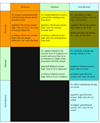A framework for studying the neurobiology of value-based decision making
- PMID: 18545266
- PMCID: PMC4332708
- DOI: 10.1038/nrn2357
A framework for studying the neurobiology of value-based decision making
Abstract
Neuroeconomics is the study of the neurobiological and computational basis of value-based decision making. Its goal is to provide a biologically based account of human behaviour that can be applied in both the natural and the social sciences. This Review proposes a framework to investigate different aspects of the neurobiology of decision making. The framework allows us to bring together recent findings in the field, highlight some of the most important outstanding problems, define a common lexicon that bridges the different disciplines that inform neuroeconomics, and point the way to future applications.
Figures


References
-
- Sutton RS, Barto AG. Reinforcement Learning: An Introduction. Cambridge: MIT Press; 1998.
-
- Association AP. 2000
-
- Bossaerts P, Hsu M. In: Neuroeconomics: Decision Making and the Brain. Glimcher PW, Camerer CF, Fehr E, Poldrack RA, editors. New York: Elsevier; 2008.
-
- Balleine BW, Daw N, O'Doherty J. In: Neuroeconomics: Decision-Making and the Brain. Glimcher PW, Fehr E, Camerer C, Poldrack RA, editors. New York: Elsevier; 2008.
-
- Nestler EJ, Charney DS. The Neurobiology of Mental Illness. Oxford: Oxford University Press; 2004.
Publication types
MeSH terms
Grants and funding
LinkOut - more resources
Full Text Sources

